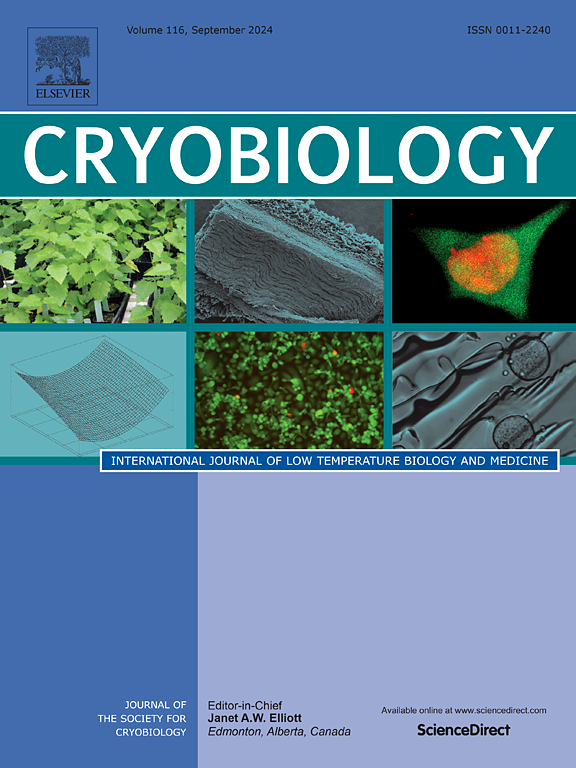冷冻保护剂及其浓度对羊驼附睾精子解冻后质量的影响
IF 2.1
3区 生物学
Q2 BIOLOGY
引用次数: 0
摘要
精子的冷冻保存需要使用冷冻保护剂(CPAs)来减少膜损伤并在解冻后保持细胞功能。在南美洲的骆驼科动物中,甘油(GL)、乙二醇(EG)和二甲亚砜(DMSO)是最广泛使用的cpa。然而,在其他物种中的一些研究已经探索了酰胺基CPAs的潜力,如二甲乙酰胺(DMA)、二甲基甲酰胺(DMF)和甲基甲酰胺(MF)。本研究旨在利用6 × 3因子设计(6个CPA × 3浓度:1%、3.5%和7%)评估CPA类型和浓度对羊驼解冻后精子质量的相互作用。解冻后评估包括总运动性(明场显微镜)、活力(SYBR14/PI)和线粒体膜电位(MMP) (MitoTracker Deep Red),后两者通过成像流式细胞术测量。数据分析采用双向方差分析确定主效应和相互作用。与7%的CPA浓度相比,1%和3.5%的CPA浓度显著提高了运动性、活力和MMP值(P < 0.05)。DMSO和GL的解冻后活力显著高于DMA和DMF (P < 0.05),但CPAs之间的活力和MMP无显著差异。综上所述,CPA浓度比CPA类型对解冻后精子质量的影响更大,且浓度在1% ~ 3.5%之间对保持羊驼附睾精子的活力、活力和线粒体功能最优。本文章由计算机程序翻译,如有差异,请以英文原文为准。
Comparison of cryoprotectant agents and their concentrations on the post-thaw quality of alpaca (Vicugna pacos) epididymal spermatozoa
Cryopreservation of spermatozoa requires the use of cryoprotective agents (CPAs) to minimize membrane damage and preserve cell function after thawing. In South American camelids, glycerol (GL), ethylene glycol (EG), and dimethyl sulfoxide (DMSO) are the most widely used CPAs. However, some studies in other species have explored the potential of amide-based CPAs, such as dimethylacetamide (DMA), dimethylformamide (DMF), and methylformamide (MF). This study aimed to evaluate the interaction between CPA type and concentration on post-thaw sperm quality in alpacas using a 6 × 3 factorial design (six CPAs × three concentrations: 1 %, 3.5 %, and 7 %). Post-thaw assessments included total motility (bright-field microscopy), viability (SYBR14/PI), and mitochondrial membrane potential (MMP) (MitoTracker Deep Red), with the latter two measured by imaging flow cytometry. Data were analyzed using two-way ANOVA to determine main effects and interactions. CPA concentrations of 1 % and 3.5 % produced significantly higher values for motility, viability, and MMP compared to 7 % (P < 0.05). DMSO and GL exhibited significantly higher post-thaw motility (P < 0.05) than DMA and DMF, although no significant differences among CPAs were observed for viability or MMP. In conclusion, CPA concentration has a greater impact than CPA type on post-thaw sperm quality, and concentrations between 1 % and 3.5 % are optimal for preserving motility, viability, and mitochondrial function in alpaca epididymal spermatozoa.
求助全文
通过发布文献求助,成功后即可免费获取论文全文。
去求助
来源期刊

Cryobiology
生物-生理学
CiteScore
5.40
自引率
7.40%
发文量
71
审稿时长
56 days
期刊介绍:
Cryobiology: International Journal of Low Temperature Biology and Medicine publishes research articles on all aspects of low temperature biology and medicine.
Research Areas include:
• Cryoprotective additives and their pharmacological actions
• Cryosurgery
• Freeze-drying
• Freezing
• Frost hardiness in plants
• Hibernation
• Hypothermia
• Medical applications of reduced temperature
• Perfusion of organs
• All pertinent methodologies
Cryobiology is the official journal of the Society for Cryobiology.
 求助内容:
求助内容: 应助结果提醒方式:
应助结果提醒方式:


